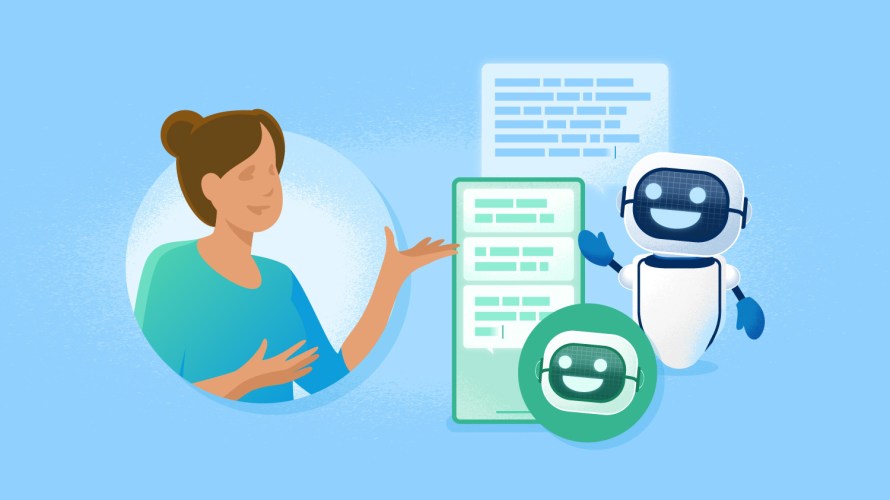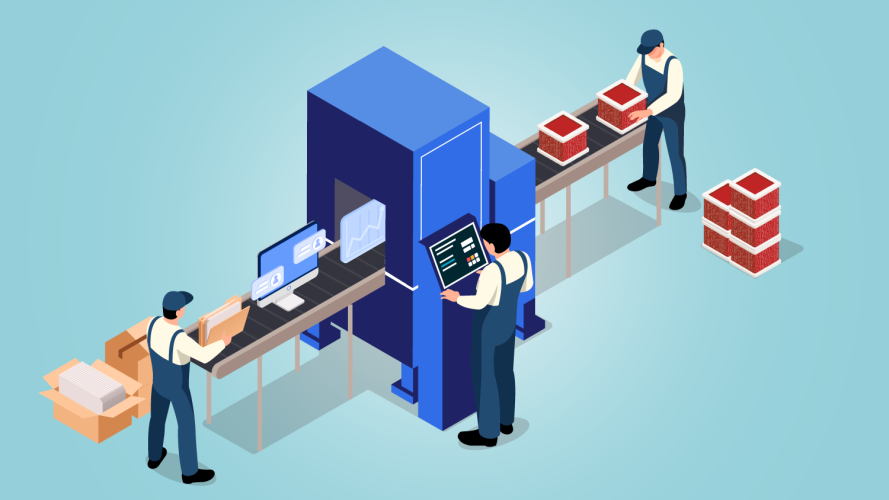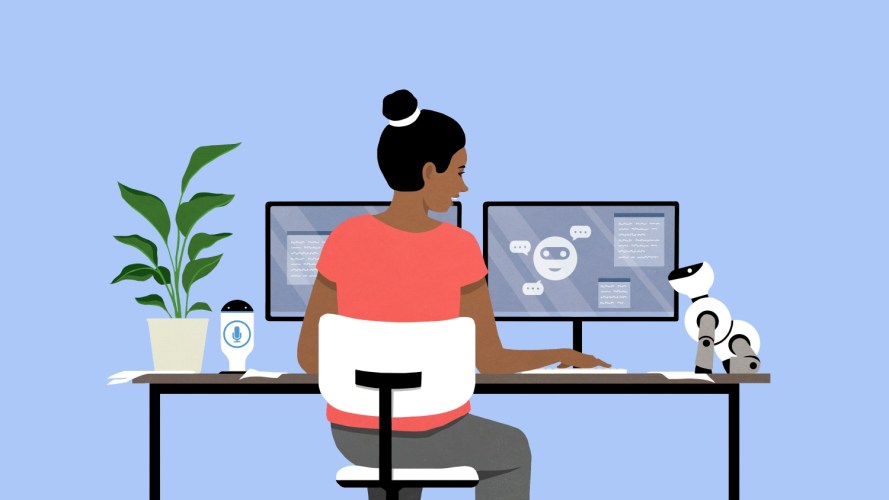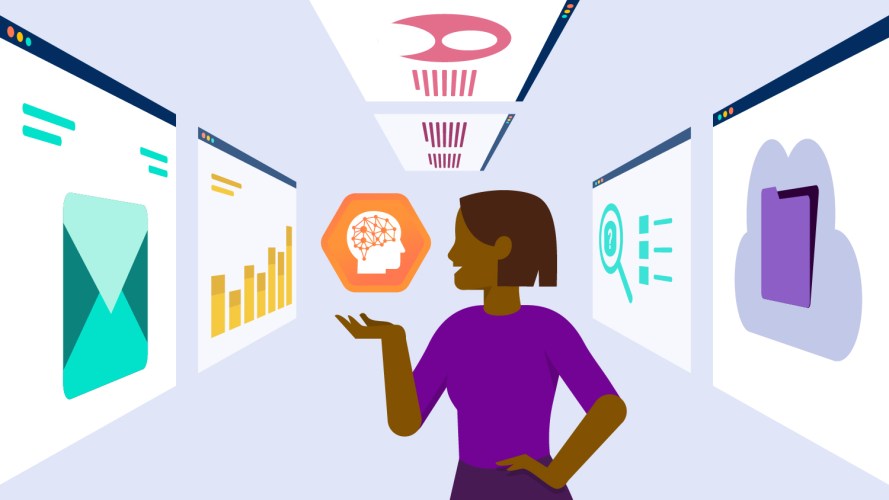If you’ve ever chatted with an online customer support agent or asked Siri what the official state bird of Rhode Island is, you’ve interacted with a chatbot.
These handy digital assistants are great at answering simple questions and performing basic tasks, but in the era of generative artificial intelligence (AI), they can feel pretty limited. Ask Siri for a list of your most important sales prospects by region and it’ll probably offer to Google it for you.
An AI agent, on the other hand, is like having a digital AI assistant built into your workflow. Need help prioritizing your top sales prospects for the day? Looking for a quick summary of the service team meeting you missed this morning? Hitting a creative wall and need some marketing copy tailored to your customer demographic? An agent that’s grounded in your company’s unique data can help you with all of that.
Still, given the conversational nature of both, it’s natural to wonder where chatbots end and agents begin. Read on to find out.
What is a chatbot?
A traditional chatbot is a computer program that uses pre-defined rules, decision trees, and scripted responses to interact with users. Powered by a less advanced form of AI that enables natural-language processing (NLP), chatbots typically require substantial training and fine-tuning to accurately process user requests. These chatbots, which have been around since Joseph Weizenbaum created ELIZA in 1964, are primarily used for information retrieval, to handle basic interactions, and to answer common customer support questions. And although chatbots have conversational interfaces similar to an AI agent, they don’t understand language in the same way large language models (LLMs) do.
Their ability to provide quick, consistent responses to common questions makes them a reliable, cost-effective solution for handling routine customer service inquiries, collecting basic information, and suggesting relevant resources. However, their ability to understand context and learn from interactions is limited, as is their capacity to handle queries outside predefined conversational flows. So while they’re effective for straightforward, repetitive tasks, they struggle with more open-ended conversations.
“The conversational flow itself, in traditional bots, is built in a very declarative and pre-defined manner. It doesn’t give you the full natural conversational experience,” said Abhi Rathna, a product management director on the Salesforce AI team.
Think of a chatbot like a vending machine: It has a fixed inventory of snacks (predetermined responses), a small keypad for user inputs (the queries you can pose), and it can only give you exactly what you selected (a scripted response). It’s simple, predictable, and it works well if you need to serve a particular need.
Chatbots are well-suited for scenarios where it’s crucial for all responses to adhere to brand messaging guidelines. “For users with a very specific brand voice who want to be prescriptive about conversation flows in key scenarios, traditional bots would give them the capability to control those conversations,” Rathna said.
What is an AI agent?
An AI agent is an advanced AI assistant designed to augment human capabilities across a wide range of tasks. Unlike more limited chatbots, AI agents (also known as autonomous agents) can understand and generate natural language, process and analyze large amounts of information, and assist with complex activities such as writing, coding, problem solving, and creative tasks.
Because these systems are typically built on large language models (LLMs) trained on vast amounts of data, they can better engage in more nuanced and context-aware interactions. And for a company to generate personalized outputs or uncover important business insights, an agent can also be grounded in your unique business data — including both structured data, like a spreadsheet or database, and unstructured data, like PDFs, emails, and chat logs.
And because AI agents can adapt to and learn from interactions, they’re versatile tools that excel in enhancing productivity and decision-making.
“An AI agent uses a large language model to orchestrate conversations, which makes it very easy to create a natural flow, while also cutting down configuration time,” Rathna said. “The agent does a better job of understanding intent and matching it to the right answers.”
If a chatbot is akin to a vending machine, an AI agent is like a personal chef with an impressive repertoire of recipes (vast knowledge base), an ability to understand complex dish requests (natural language processing), and can learn new meals that adapt to your preferences (ability to learn from historical data).
What are the differences between a chatbot and an agent?
Chatbots differ from AI agents in many important ways, including their capabilities, the ways in which they’re trained, and the time it takes to implement them.
Where chatbots largely follow rules-based dialogues and are limited to answering predefined questions, AI agents can reason and ground answers in relevant knowledge and content. Customer service chatbots, unlike agents, need extensive training on hundreds of utterances to be able to understand natural-language requests, making agents significantly quicker and easier to implement and launch. Additionally, agents don’t require rule-based dialogs and configuration to call actions and guide the conversation.
So what does all that mean for determining which one is best for your business? It might come down to customer-facing needs versus employee-facing ones, Rathna says.
“For primarily customer-facing scenarios, I think there will be a mix of traditional chatbots and modern generative AI agents. For employee-facing scenarios, an agent is more favorable,” he said. “Our Einstein Copilot is integrated in the flow of work alongside other business processes. And that, combined with quick integration, will make for faster adoption.”
In the short term, as the reliability of generative AI responses continues to improve, Rathna sees a hybrid model as a good option for many customers.
“What I foresee is customers using chatbots in some cases where they want to be more prescriptive and have more control, and using agents for other use cases where they’re comfortable letting generative AI control the conversation. The technology is still evolving, so maybe this changes in a few years, but until then, we should think of agents and chatbots as a better together story.”
Will AI agents replace chatbots?
As AI technology continues to evolve, AI agents are poised for dramatic growth in the coming years. Agent interactions will become more intuitive across text, voice, and visual mediums, and improved contextual understanding will be key in allowing them to provide more relevant information over time.
And while the evolution of traditional chatbots won’t be as exciting as that of AI agents, we’ll see practical advancements in user experience, enhanced integration with other business systems, and easier implementation of customized chatbot flows and responses.
As we all collectively navigate this rapidly evolving AI landscape, understanding the ways that both chatbots and agents can uniquely benefit your business — both now and in the future — will be important for maximizing their impact. Whether employing a chatbot, an agent, or taking a hybrid approach and using both in tandem, these tools will undoubtedly play increasingly meaningful roles in business operations, reshaping how we interact with technology and each other.


































